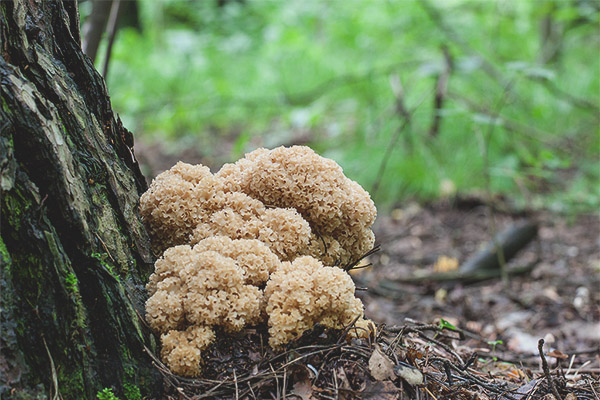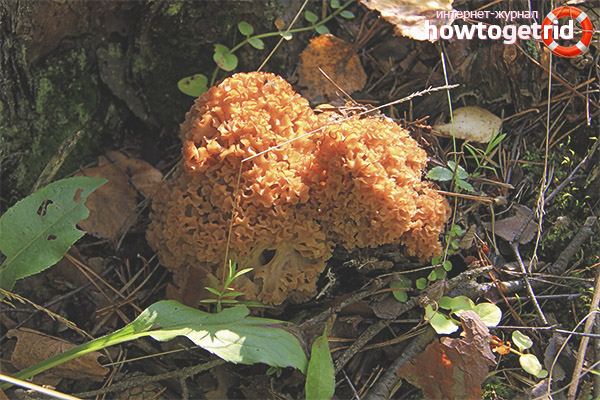The content of the article
Curly sparass is understood in the literal sense of the word as a curly-colored beige-colored mushroom, which belongs to the sparass family. In this family, no more than 7 species, which is remarkable. The mushroom belongs to edible and very tasty varieties, but it is listed in the Red Book of our country as an endangered type. Due to deforestation and gathering of people represented by the specimens is becoming less. Today we will study everything connected with them.
Description
- Once again, this variety is classified as edible. The mushroom attracts attention, first of all, due to the fact that it is famous for its external data. In common people it is called differently, including mushroom cabbage, lamb mushroom, mushroom happiness, as well as hare cabbage and mushroom king. Moreover, the name "lamb" is used only in foreign reference materials, our compatriots practically do not express it that way.Russian experts under the lamb imply a completely different mushroom - curly griffin.
- Now consider the description of the presented convoluted instance. The fruit body consists of multiple curly leaves that branch and look like a shrub. The mushroom is large enough, its wrinkled lobes with wavy edges can not go unnoticed. Considering the diameter, it can be said that some fruit bodies grow up to 20–60 cm. Of course, this is rare, on average there are mushrooms in a diameter of 7–30 cm. The height of the shrub is about 20 cm and its weight exceeds 6–8 kg . Some mushroom pickers came across copies of 10-14 kg.
- Fruit bodies in shade beige, yellow-white. In mature specimens, the color is dark brownish with reddish patches. The base looks bad, it is root-like, attached to the center of the calf. The thickness of the leg is about 5 cm. For the most part it is dug into the ground, therefore it is not peeped. It grows up to 13 cm in length, turns white-yellow, can darken and become black when overripe.
- The soft part of the peculiar wavy blades is fragile, it easily crumbles and breaks.In grown fruit bodies, it is hard and solid. To taste nutty, it smells strange. The smell has nothing to do with the mushroom flavor. Reproduction is carried out by spores of elliptical shape, they are light in color with yellow or white.
- The layer, which is otherwise called sporiferous, prefers to be placed exactly on each blade. Moreover, it occupies only one side, not completely spinning. In hue, this layer is pigmented creamy white or gray. Feels a little rough, it may be overly smooth.
Sprouting
- Mushrooms of the family under discussion prefer to dwell in the Northern Hemisphere. They are met in formed conifers and mixed foxes with broad-leaved trees. Usually located near Khabarovsk, Krasnodar, Altai, Karelia, Moscow, Sakhalin, Chelyabinsk. They are also not rare in the Caucasus, in Primorye. Naturally, it does not do without Georgia and North America, Asia and the Baltic States.
- Fruiting begins in August and ends in September. Here is such a short yield season. These mushrooms are ranked as parasites, that is, they settle on the roots of trees and gradually destroy them.Growth is carried out one by one among pines, but colonies of fungi in other coniferous stripes can be found. Occurs in larch, cedar pine forest and near fir.
- In some climatic zones, these mushrooms prefer to settle on stumps, which are connected with the base of the tree and its root system in particular. This type of sparass can cause the death of plants due to the development of brown-red rot.
Edibility
- The fruit bodies discussed are classified as edible mushrooms. Often, such instances are included in the recipe when cooking soups and fried foods. Also, often such fruits are dried. Separately, it is worth noting that only young specimens can be taken as food.
- The problem is that with age, the fungi gain excessive rigidity. They also turn brown and become unbearably bitter. As for the young fruits, they have an excellent taste. By texture, these mushrooms are very similar to morel. The smell of the mushrooms in question is rather unusual, and the taste is nutty.
- In the culinary world, fruit bodies are often used raw.This mushroom perfectly complements salads, cheese casseroles, soups. In addition, the fruit goes well with seafood and nuts. The presented specimens are also marinated. The mushrooms are dried and the finished powder is added as a seasoning.
Similar species
- These mushrooms have a unique appearance. In addition, the special distribution area allows you to completely eliminate the possibility of confusing such an instance with any other fungus. However, it is worth noting that the externally viewed fruit is very similar to the lamellar sparasis.
- Do not be upset ahead of time, these mushrooms are easy to distinguish from each other. Plate fruits have more rigid plates with solid edges. They are painted yellow.
- Moreover, such an instance grows predominantly on oak. It is worth noting that the mushroom is also edible. It has a pleasant aroma and amazing taste. The specimen is also protected and is extremely rare.
Treatment
- The pulp of mushrooms is very delicate, and the amazing taste can not leave anyone indifferent. It is due to its taste and curly sparases became famous in the culinary world.
- As mentioned earlier, only young mushrooms are suitable for food. Before cooking, be sure to wash the fruit body from the ground. This task is not their lungs.
In addition to excellent taste, the specimen in question has a mass of beneficial qualities. This mushroom is successfully used in folk medicine. Thanks to special compounds, it is possible to suppress the development of tumors in the body.
Video: Sparassis crispa (Sparassis crispa)












To send